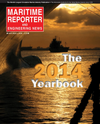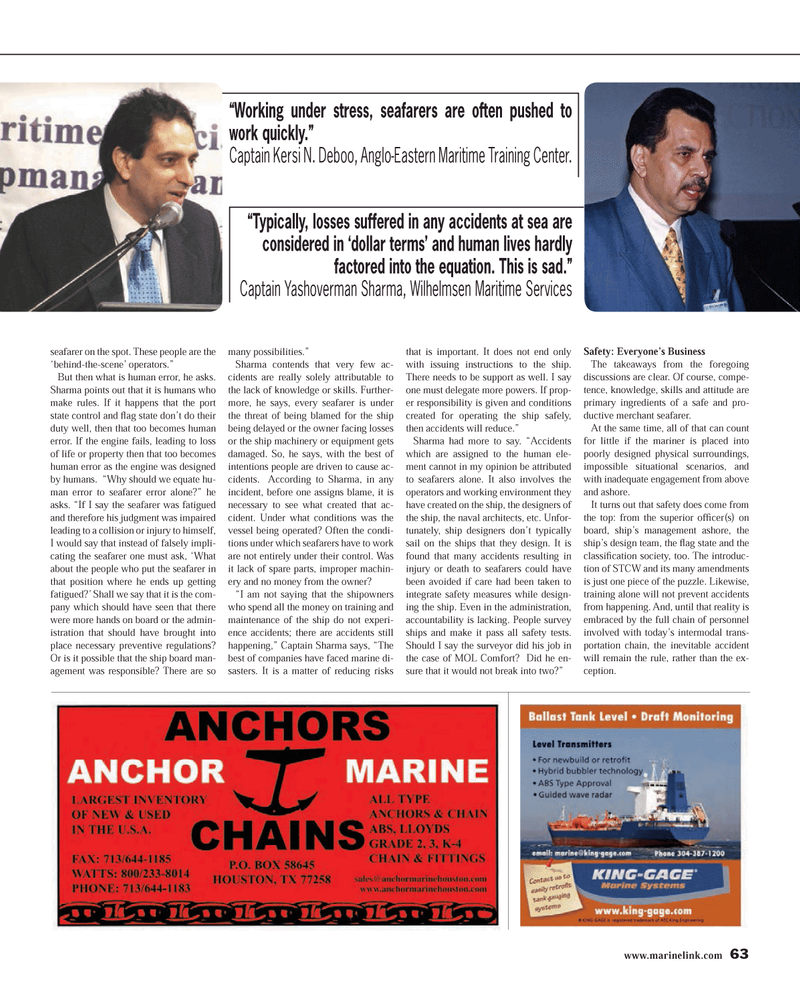
Page 63: of Maritime Reporter Magazine (June 2014)
Annual World Yearbook
Read this page in Pdf, Flash or Html5 edition of June 2014 Maritime Reporter Magazine
www.marinelink.com 63 seafarer on the spot. These people are the ‘behind-the-scene’ operators.”
But then what is human error, he asks.
Sharma points out that it is humans who make rules. If it happens that the port state control and ? ag state don’t do their duty well, then that too becomes human error. If the engine fails, leading to loss of life or property then that too becomes human error as the engine was designed by humans. “Why should we equate hu- man error to seafarer error alone?” he asks. “If I say the seafarer was fatigued and therefore his judgment was impaired leading to a collision or injury to himself,
I would say that instead of falsely impli- cating the seafarer one must ask, ‘What about the people who put the seafarer in that position where he ends up getting fatigued?’ Shall we say that it is the com- pany which should have seen that there were more hands on board or the admin- istration that should have brought into place necessary preventive regulations?
Or is it possible that the ship board man- agement was responsible? There are so many possibilities.”
Sharma contends that very few ac- cidents are really solely attributable to the lack of knowledge or skills. Further- more, he says, every seafarer is under the threat of being blamed for the ship being delayed or the owner facing losses or the ship machinery or equipment gets damaged. So, he says, with the best of intentions people are driven to cause ac- cidents. According to Sharma, in any incident, before one assigns blame, it is necessary to see what created that ac- cident. Under what conditions was the vessel being operated? Often the condi- tions under which seafarers have to work are not entirely under their control. Was it lack of spare parts, improper machin- ery and no money from the owner? “I am not saying that the shipowners who spend all the money on training and maintenance of the ship do not experi- ence accidents; there are accidents still happening,” Captain Sharma says, “The best of companies have faced marine di- sasters. It is a matter of reducing risks that is important. It does not end only with issuing instructions to the ship.
There needs to be support as well. I say one must delegate more powers. If prop- er responsibility is given and conditions created for operating the ship safely, then accidents will reduce.”
Sharma had more to say. “Accidents which are assigned to the human ele- ment cannot in my opinion be attributed to seafarers alone. It also involves the operators and working environment they have created on the ship, the designers of the ship, the naval architects, etc. Unfor- tunately, ship designers don’t typically sail on the ships that they design. It is found that many accidents resulting in injury or death to seafarers could have been avoided if care had been taken to integrate safety measures while design- ing the ship. Even in the administration, accountability is lacking. People survey ships and make it pass all safety tests.
Should I say the surveyor did his job in the case of MOL Comfort? Did he en- sure that it would not break into two?”
Safety: Everyone’s Business
The takeaways from the foregoing discussions are clear. Of course, compe- tence, knowledge, skills and attitude are primary ingredients of a safe and pro- ductive merchant seafarer.
At the same time, all of that can count for little if the mariner is placed into poorly designed physical surroundings, impossible situational scenarios, and with inadequate engagement from above and ashore.
It turns out that safety does come from the top: from the superior of? cer(s) on board, ship’s management ashore, the ship’s design team, the ? ag state and the classi? cation society, too. The introduc- tion of STCW and its many amendments is just one piece of the puzzle. Likewise, training alone will not prevent accidents from happening. And, until that reality is embraced by the full chain of personnel involved with today’s intermodal trans- portation chain, the inevitable accident will remain the rule, rather than the ex- ception. “Working under stress, seafarers are often pushed to work quickly.”
Captain Kersi N. Deboo, Anglo-Eastern Maritime Training Center. “Typically, losses suffered in any accidents at sea are considered in ‘dollar terms’ and human lives hardly factored into the equation. This is sad.”
Captain Yashoverman Sharma, Wilhelmsen Maritime Services
MR #6 (58-65).indd 63 6/10/2014 9:36:31 AM

 62
62

 64
64
